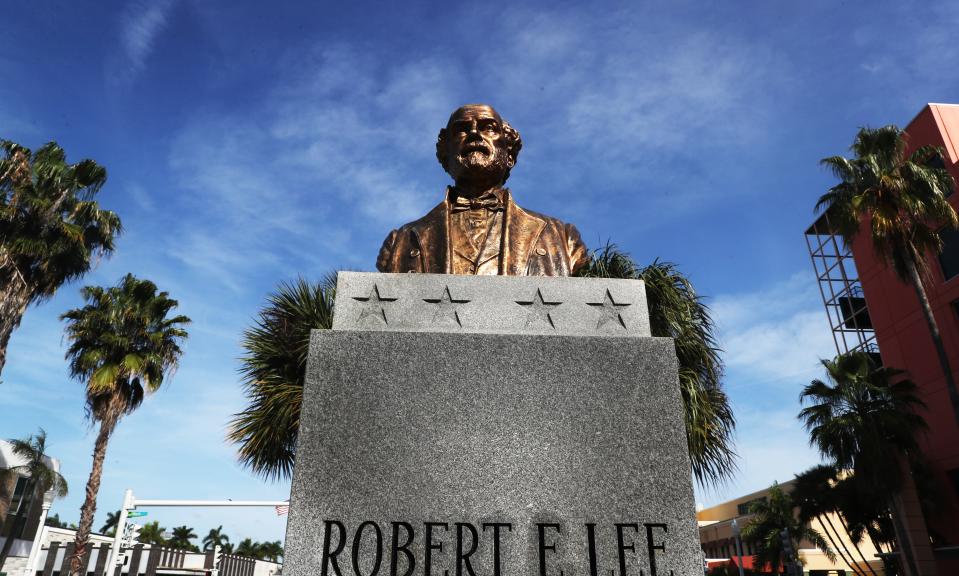Lee County’s namesake: how it was founded and the controversy that follows years later
- Oops!Something went wrong.Please try again later.
Lee County celebrated its birthday this past weekend, turning 136 years old on May 13.
Home to over 800,000 residents, the Southwest Florida county has grown a sturdy reputation over the years for its coastal lifestyle, abundant wildlife, historical homes, and expanding market.
But before any of the development or bulk of the residents showed up, how did Lee County get its name? To answer that question, we combed our archives and found the scoop on Lee County's history.
Latest update on Robert E. Lee statue: Confederate group gets personal in latest bid to restore Robert E. Lee bust
Catch up the 'The Last Ride' podcast: Listen to The Last Ride true crime podcast Episode 8, "Pursuing Justice"
How did Lee County get its name?
Lee County is named after Robert E. Lee, a Confederate general in the American Civil War who eventually commanded all Confederate armies. The name came at the urging of retired Confederate Capt. and founding Lee County Commissioner Francis Hendry.
When did it officially become Lee County?
Lee County was founded on May 13, 1887.
What was it before it was Lee County?
Lee County was originally part of Monroe County. After the area’s only schoolhouse burnt down, residents traveled to the county seat in Key West to get funding for rebuilding. They were denied any funding and were told they should have taken better care of their previous schoolhouse.
Angered by the Key West politicians, residents petitioned the state to form their own county and it was granted by officials in Tallahassee.
How was the name received back then?
According to Hendry's 1908 memoir, he wrote that the name was celebrated yet met with some protest from locals.
“I remember the enthusiasm in adopting the motion,” Hendry wrote. “I must narrate a little incident which occurred the next day … Someone stepped in and said: ‘Judge, some people are protesting against the name of our proposed new county.’”
Very little is known about the protestors or what was said as former efforts to learn more about the protesters, who they were, and how many, were unsuccessful.
It is known that Judge Cranford, who would go on to have Cranford Street in Fort Myers named for him, “flashed fire” in his eyes at the protesters, Hendry wrote.
He said: “Let them protest and be _____.”
“I will leave the dash to be filled in by my dear friend, Judge Cranford,” Hendry wrote. “Yes, we are proud of the name of our county and its seat of government.”
How are residents, officials reacting to the name over 130 years later?
Decades later, many individuals groups remain divided on the county's namesake, going as far as to write petitions and remove statutes.
In May 2020, the Robert E. Lee bust in downtown Fort Myers was been removed from its pedestal. The bust was originally put up in the mid-1960s after multiple fundraising drives by the now-defunct Laetitia Ashmore Nutt Chapter of the United Daughters of the Confederacy.
The pedestal has since also been removed. The bust is currently with the Sons of Confederate Veterans, an American neo-Confederate nonprofit organization of male descendants of Confederate soldiers.

There has since been a campaign to restore the statue, the Coalition to Restore the Lee Memorial launching last spring to bring back the Lee monument removed by the city from a memorial display on Monroe Street in Fort Myers.
2020 also saw a major petition to change the name of the county, a group seeing over 8,000 signatures asking Lee County to change its name to Calusa County, after the indigenous Native American tribe that lived in Southwest Florida first.
The following year, Fort Myers residents Cesar Aguilera and Brian Weaver received buzz after they launched an online petition to rebrand Lee County to Bruce Lee County, not Robert E. Lee County. It raised 1,156 signatures.
The local artists claimed the Asian-American martial arts star was a better representation of the county instead of a Confederate soldier.
“His achievements are pretty amazing,” Weaver told the News-Press in 2021. “I would be extremely proud to live in Bruce Lee County. And I think it’d be really cool to have a giant statue of Bruce Lee downtown.”
Neither of the petitions led to any change.
This article originally appeared on Fort Myers News-Press: Lee County: The history behind the county's controversial namesake

